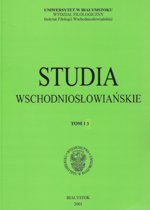Obraz Cerkwi unickiej w obwodzie białostockim na początku XIX wieku
A view of uniate church in the Bialystok district at the beginning of xix century
Author(s): Irena MatusSubject(s): History, History of Church(es), Essay|Book Review |Scientific Life, Theology and Religion, Cultural Essay
Published by: Wydawnictwo Uniwersytetu w Białymstoku
Keywords: cerkiew unicka; latynizacja; polonizacja
Summary/Abstract: Uniate Church in the Republic of Poland was established as a result of the Brest Union in 1596. During the following centuries it evolved towards Latin Church. Mainly on the basis of the adopted by zamoyski synod (1720) resolutions it underwent widespread Latinizing and Polonization. It concerned the dogma, liturgy, church services, rituals, laity and clergy. The interiors of the churches were changed, iconostasis, sacrificial tables and altars equipped according to the Greek rite were removed. The main and side altars, confessionals, pulpits, organs and other Latin utensils were introduced instead. The actions of the Basilian congregation were of equal significance. As a result of those changes the Uniate Church gradually wondered off from the eastern rite bringing itself closer to the Latin one. The Polonization was in full swing. Old Slavonic was replaced by Polish. From that moment on this was the language of prayers, sermons, religious singing and communication with the priests. At the turn of the 18th and 19th centuries Polonization of the Unite Church was advanced. The prestige of the clergy and of the Church as an institution didn’t raise, what was expected at the moment of introducing the union, the same could be said about its economic situation. All that was leading to the fall. The situation was worsened by the fact that the church founders, most often of the different faith weren’t interested in supporting financially the churches of their serfs. The sad picture of the Uniate Church emerges from the deans’ inspections from the end of 18th and the beginning of 19th century. In the Bialystok district constituting the religious and ethnic borderland Latinizing and Polonization of the Uniate Church were the most intensive.
Journal: Studia Wschodniosłowiańskie
- Issue Year: 2015
- Issue No: 15
- Page Range: 587-608
- Page Count: 22
- Language: Polish

